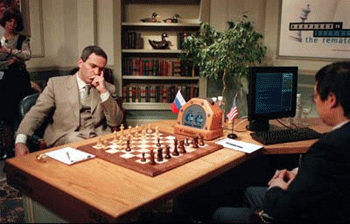This is a post from Minyanville.com, written by Susannah Breslin.
In man’s modern-day battle against the robots, the winner last week was abundantly clear. Watson, an IBM computer, appeared on “Jeopardy!” and soundly annihilated his two human opponents, previous “Jeopardy!” champions Ken Jennings and Brad Rutter. The show was the finale of a three-night throw down pitting an oversized computer chip against flesh-and-blood trivia nerds.
At the end of the first day, Watson was tied with Rutter at $5,000, and Jennings held a mere $2,000. At the end of the second day, Watson was in the lead with a $35,734 pot, while Rutter had netted $10,400 and Jennings had scored a paltry $4,800. In the end, Watson emerged victorious to claim the tourney’s $1 million price with $77,147 to Jennings’ $24,000 and Rutter’s $21,600. “I, for one, welcome our new computer overlords,” Jennings, who won 74 consecutive “Jeopardy!” games in 2004, wrote on his video screen in surrender.
So, how can mankind expect to fare moving forward? As it turns out, the war between man and machine has only just begun.
Here’s a look at five telling man vs. machine competitions:
Deep Blue vs. Garry Kasparov
On February 10, 1996, Deep Blue, a chess-playing supercomputer created by IBM, took on the reigning chess world champion, Garry Kasparov, in a six-game matchup held over seven days — and lost. In the Russian grandmaster’s battle against what looked like a refrigerator, the human mind prevailed, with Kasparov winning three matches, drawing in two matches, and losing in one. Then someone called, “Rematch!” In May of 1997, the two met again, but this time, Deep Blue had been retooled and ominously renamed Deeper Blue. The upgraded machine trounced Kasparov 3-1/2 to 2-1/2, and Deeper Blue became the first computer to crush a human at chess.
RealDoll vs. Real Woman
For the discerning man who won’t settle for just any factory-made sex surrogate, Abyss Creations’ in San Marcos, Calif., offers the RealDoll collection, a line of high-end love dolls retailing for $5,999 to $10,000. Made of pliable silicone and a posable PVC and steel skeleton available in “10 female body types and 16 interchangeable female faces,” the anatomically correct RealDoll is the inanimate alternative to a living, breathing human female. While the RealDoll will always be there when you need her and doesn’t require expensive dates or, well, food, the drawback is that a RealDoll, unlike a real woman, will never love you back
Hand-Held Scanner vs. Human Doctor
For those who find taking a trip to the doctor’s office fills them with terror, soon they may be able to skip the Homo sapiens in the white coats and diagnose themselves with a handheld scanner. The $280 device was developed by Jürgen Lademann, head of the Dermatology, Venereology, and Allergy department at Charité -University Medicine hospital in Berlin, Germany. Aim the scanner at your skin, wait three minutes, and your health will be graded on a scale of one to ten through an analysis of your antioxidant levels. Currently, the gizmo is being tested by a group of 19-year-old college students, but don’t expect it to replace bipedal doctors in the near future. Unlike on “Star Trek,” this machine grades your overall health and doesn’t diagnose specific medical problems. Still, users can expect the same cold and distant bedside manner.
Deep Green vs. Pool Shark
Just when you thought it was safe to go back to the pool hall, the Robotics and Computer Vision Lab at Queen’s University in Ontario, Canada, spawns a pool-playing robot equipped with a spherical wrist, a series of spy cameras for expert game-play, and a vacuum-powered ball-lifter. According to its human creators, the robotic pool hustler Deep Green plays at a “better-than-amateur level,” and the goal is to pit the ‘bot against professional pool players. Regardless of how Deep Green fares against the likes of, say, Jeanette Lee, Maxim model and the author of The Black Widow’s Guide to Killer Pool, we’re going to have to bet that she’d look better doing it.
High-Frequency Trading vs. Human Trading
If following your intuition, wearing your lucky sneakers, and watching Jim Cramer rant and rave like an insane asylum escapee on “Mad Money” isn’t making you a killing in the stock market, high-frequency trading is the computer-generated alternative. Here, the human brain is replaced by computer programs that can read market algorithms faster than you can. Sounds smart, right? Historically, trusting the computerized over the humanized can be risky. (Didn’t you see “2001: A Space Odyssey”?) The S.E.C.’s report on the May 6, 2010 stock market crash has regulators pointing the finger at HFT for contributing to market volatility, although high-frequency fans argue the practice has an overall stabilizing market effect.





